I didn't do it when I went to Montreal, or New Orleans, or Denver. But this time, I promised, I was going to write about my day trip to Philadelphia, like really really write about it. So . . . here's part ONE What I Learned On My One-Day Summer Vacation to Philly:
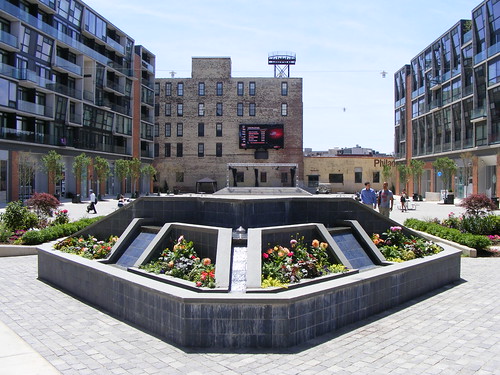
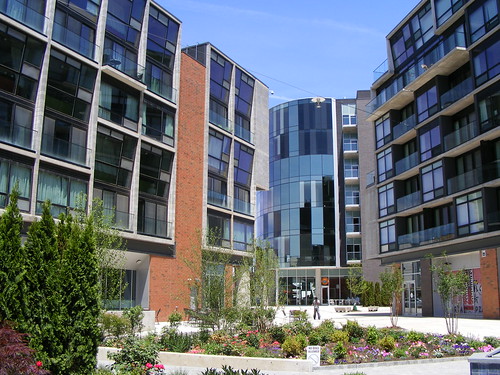
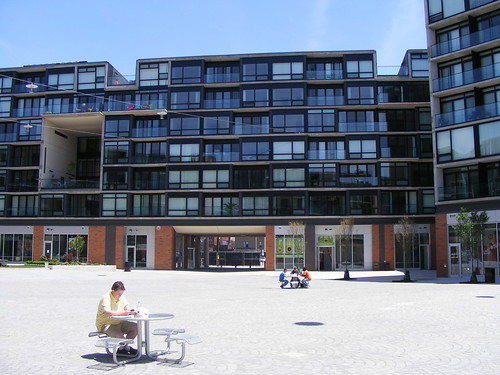
That traditional urbanism doesn't require traditional architecture.
I've heard the complaint many, many times: places like Bethesda Row, Rockville Town Square and our own Downtown Silver Spring look "fake" or "cookie-cutter," filled with chain stores and trying way too hard to look old. It doesn't have to be that way. Philly developer Bart Blatstein based his Piazza at Schmidt's, the redevelopment of a former brewery in the gentrifying Northern Liberties neighborhood, on the Piazza Navona in Rome.
Schmidt's is the latest phase of Blatstein's plans to revitalize what's already been dubbed "NoLi," a community north of Center City where decaying factories rub elbows with sleek new condominiums. Reading about the project in the Philadelphia Inquirer after it first opened last month was my inspiration for making the trip north.
Despite its ancient precedents, the Piazza at Schmidt's doesn't have a single Doric column - just lots of glass and concrete. Yet even with that combination of materials, you're not looking at your standard suburban office park, either. Suggesting that urban design isn't tethered to a specific style, the Piazza is a space that feels comfortable whether you're with six people or six hundred people. Blatstein, who cut his teeth building strip malls throughout the region, did an about-face with this project, filling it with everything from a 1950's diner to a store that sells clothes for hipster babies.
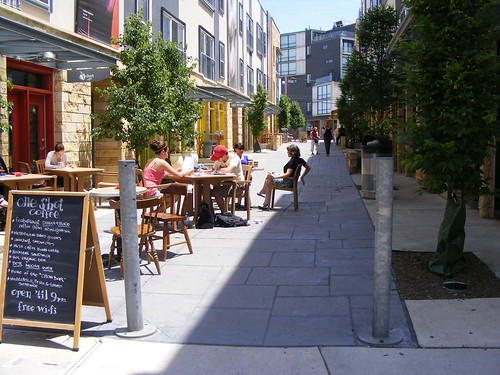
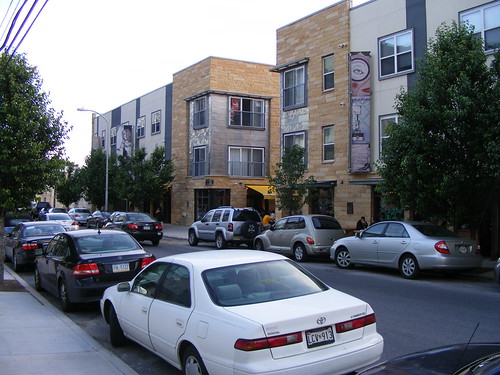
Big changes come in very small packages.
Blatstein's first project in the neighborhood was Liberties Walk, a four-block-long pedestrian street lined with shops and apartments, and you could say it's the little drop that made a big wave in NoLi. The architecture is simple and the materials are cheap - almost embarassingly so. The retail here swings a little closer to what you might call "useful things" (warning! PDF file): a coffee shop, a bike store, a dry cleaner.
But the investment alone drew attention to the neighborhood - and, even better, it gave locals a place not just to run errands but hang out, putting life back on the street. Acknowledging that some errands require a car, and that visitors from other parts of the region won't be willing to walk five blocks from the nearest metro and streetcar stop, parking is plentiful and free (for now, at least). But it's tucked in back, away from the action.
Liberties Walk could be a very good model for redeveloping (in whole or in part) East County's aging strip malls and office parks. It's a public, urban gathering place, but on a smaller scale than a transit-oriented development like Rockville Town Square, acknowledging that rapid transit may not come to the east side for a long, long time.
That you should never go to South Street, ever.
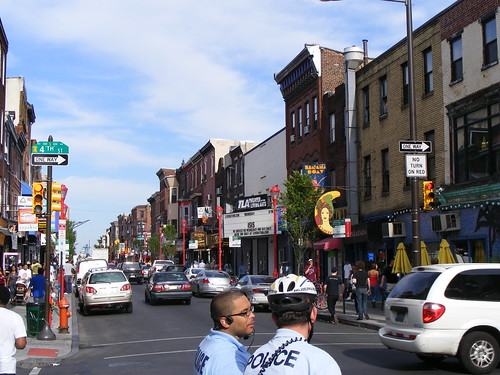
My friends and I spent maybe an hour on South Street - or two hours, counting the hour we spent looking for parking. It's kinda like Georgetown, except instead of stores like Urban Outfitters you have pawn shops and a place called Condom Kingdom, which was cute when I went there three years ago, but not so much now. Other than its proximity to I-95 - which itself is next to the Delaware River - there isn't much of a reason I found to come back here.
There was a cool record store that seemed to have closed and, of course, the Fillmore at the Theatre of the Living Arts, the much cooler cousin of what we may get here in Downtown Silver Spring.
Come back next week for part TWO; meantimes, check out this photoset on Flickr. And, of course, a special thanks to Bossi for providing so many tips about what to see in his hometown.



That traditional urbanism doesn't require traditional architecture.
I've heard the complaint many, many times: places like Bethesda Row, Rockville Town Square and our own Downtown Silver Spring look "fake" or "cookie-cutter," filled with chain stores and trying way too hard to look old. It doesn't have to be that way. Philly developer Bart Blatstein based his Piazza at Schmidt's, the redevelopment of a former brewery in the gentrifying Northern Liberties neighborhood, on the Piazza Navona in Rome.
Schmidt's is the latest phase of Blatstein's plans to revitalize what's already been dubbed "NoLi," a community north of Center City where decaying factories rub elbows with sleek new condominiums. Reading about the project in the Philadelphia Inquirer after it first opened last month was my inspiration for making the trip north.
Despite its ancient precedents, the Piazza at Schmidt's doesn't have a single Doric column - just lots of glass and concrete. Yet even with that combination of materials, you're not looking at your standard suburban office park, either. Suggesting that urban design isn't tethered to a specific style, the Piazza is a space that feels comfortable whether you're with six people or six hundred people. Blatstein, who cut his teeth building strip malls throughout the region, did an about-face with this project, filling it with everything from a 1950's diner to a store that sells clothes for hipster babies.


Big changes come in very small packages.
Blatstein's first project in the neighborhood was Liberties Walk, a four-block-long pedestrian street lined with shops and apartments, and you could say it's the little drop that made a big wave in NoLi. The architecture is simple and the materials are cheap - almost embarassingly so. The retail here swings a little closer to what you might call "useful things" (warning! PDF file): a coffee shop, a bike store, a dry cleaner.
But the investment alone drew attention to the neighborhood - and, even better, it gave locals a place not just to run errands but hang out, putting life back on the street. Acknowledging that some errands require a car, and that visitors from other parts of the region won't be willing to walk five blocks from the nearest metro and streetcar stop, parking is plentiful and free (for now, at least). But it's tucked in back, away from the action.
Liberties Walk could be a very good model for redeveloping (in whole or in part) East County's aging strip malls and office parks. It's a public, urban gathering place, but on a smaller scale than a transit-oriented development like Rockville Town Square, acknowledging that rapid transit may not come to the east side for a long, long time.
That you should never go to South Street, ever.

My friends and I spent maybe an hour on South Street - or two hours, counting the hour we spent looking for parking. It's kinda like Georgetown, except instead of stores like Urban Outfitters you have pawn shops and a place called Condom Kingdom, which was cute when I went there three years ago, but not so much now. Other than its proximity to I-95 - which itself is next to the Delaware River - there isn't much of a reason I found to come back here.
There was a cool record store that seemed to have closed and, of course, the Fillmore at the Theatre of the Living Arts, the much cooler cousin of what we may get here in Downtown Silver Spring.
Come back next week for part TWO; meantimes, check out this photoset on Flickr. And, of course, a special thanks to Bossi for providing so many tips about what to see in his hometown.

2 comments:
How can you write about Philly and not talk about Philadelphia Green and the incredible transformation their programs have made to that city. It is stunning the impact it has had. (I think their is a term for that "green blindness" or something like that.)
Also did you catch the new Green Roof on PHS HQ? A great tour to catch, if you missed and go up a again.
Here are a few links:
http://www.pennsylvaniahorticulturalsociety.org/phlgreen/parks_public.html
http://www.pennsylvaniahorticulturalsociety.org/aboutus/index.html
I lived in Philly for 6 years, then moved to White Flint last year. The devolopments over the years has reflected what seems to be an ever-present element in the city. The youth market is huge compared to that of anything we have down here. Philly is litered with Universities, art schools, film schools and art kids altogether (remember Kevin Bacon's father?). The formula for gentrification is much different there. Here, we do what we did to Chinatown, Dupont Circle, Bethesda, Silver Spring, Falls Church and Arlington. We clear it out, build top shelf and expect a higher class of citizen to pay the prices. Philly rebuilds but keeps the local demographic in mind. NorLibs and Fishtown are perfect examples. They were shitty, now they have some cool bars, venues and studio apartments. New, hip but still affordable and you wount find anyone over 45 who lives there. Economies of scale.
Post a Comment